Scalars and Vectors - Definition, Examples, Types, FAQs
Vectors are fundamental elements in physics and mathematics, representing quantities that have both magnitude and direction. Unlike scalar quantities, which can be simply added or subtracted using basic arithmetic, vector operations require special consideration of their directional components. Understanding vector addition and subtraction is essential for accurately describing physical phenomena such as forces, velocities, and displacements.
This Story also Contains
- What Is a Scalar Quantity?
- What Is a Vector Quantity?
- Different types of vector:
- Solved Example Based on Scalar and Vector
- Summary
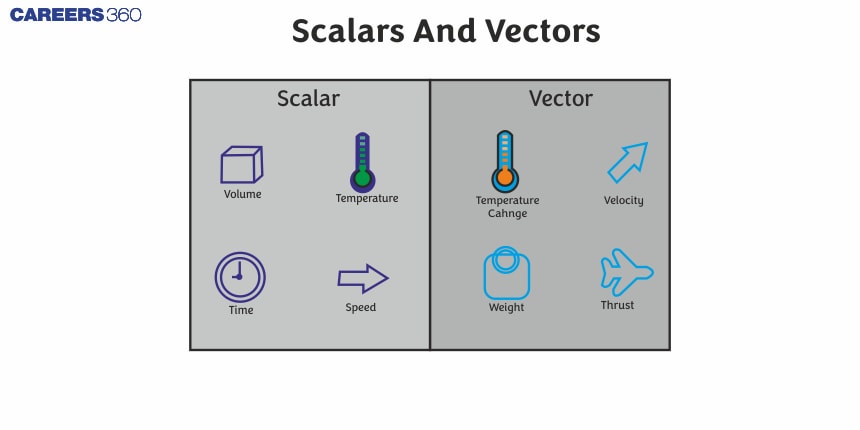
This article delves into the methods for identifying vectors and scalers starting with the definition of scalers, vectors and different types of vectors and their properties, which belongs to the chapter kinematics, which is an important chapter in Class 11 physics. It is not only essential for board exams but also for competitive exams like the Joint Entrance Examination (JEE Main), National Eligibility Entrance Test (NEET), and other entrance exams such as SRMJEE, BITSAT, WBJEE, BCECE and more. Over the last ten years of the JEE Main exam (from 2013 to 2023), one question has been asked on this concept directly and many indirectly in NEET as well.
Also read -
What Is a Scalar Quantity?
Scalar Quantity
A scalar quantity is a physical quantity that is completely described by its magnitude (size or amount) only. It does not have a direction. Scalars are simple numbers that tell "how much" of something there is.
Examples of Scalar Quantities:
- Mass (kg)
- Temperature ( ${ }^{\circ} \mathrm{C}$ or K )
- Time (s)
- Speed (m/s)
- Energy (Joules)
- Distance (m)
What Is a Vector Quantity?
A vector quantity is a physical quantity that is described by both magnitude and direction. In geometry, a vector can be represented as a directed line segment, showing both how much (magnitude) and which way (direction).
Examples of Vector Quantities:
- Force
- Velocity
- Displacement
- Position vector
- Acceleration
- Linear momentum
- Rotational momentum
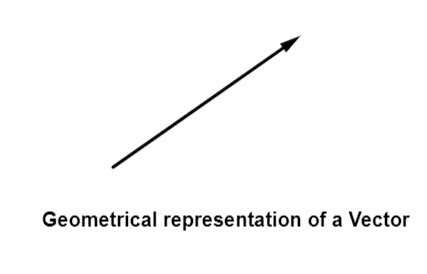
Magnitude of a vector:
The length of a vector determines its magnitude. The magnitude of a vector is sometimes referred to as the vector's norm. For a vector A, the magnitude or norm is denoted by A.
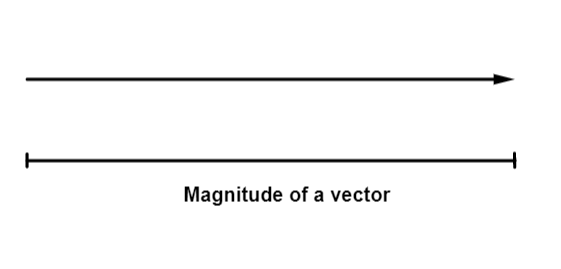
Different types of vector:
- Equal vectors
a) Collinear vectors
i) Parallel vectors
ii) Anti-parallel vectors
- Unit vector
- Orthogonal unit vectors
Equal vectors:
Two vectors A and B are said to be equal since it have equal magnitude as well as same direction along with represent the same physical quantity.
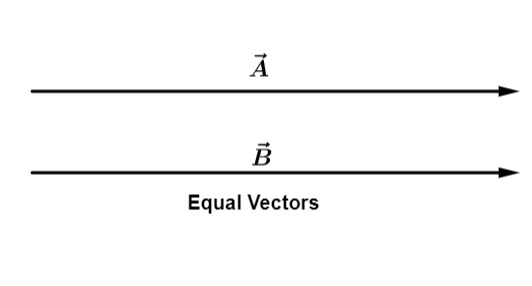
a) Collinear vectors:
Collinear vectors are vectors that lie along the same straight line or along parallel lines. They may point in the same direction or in opposite directions, but their line of action is the same.
i) Parallel vectors:
The angle formed by two vectors A and B acting in same direction along same line is 0o.
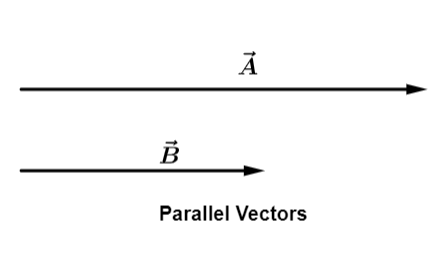
ii) Anti-parallel vectors:
When two vectors A and B are in opposite directions along same line, they are said to be antiparallel. The angle between them is then 180o.
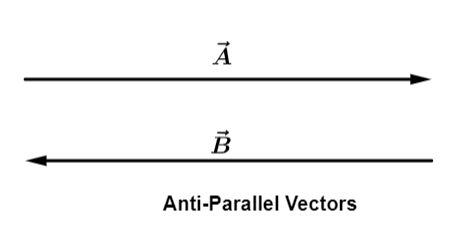
Unit vector:
A unit vector is a vector whose magnitude is divided by its length. The unit vector for A is denoted by A. It has a magnitude of one or unity. As a result, we can declare that the unit vector just provides the vector quantity's direction.
Orthogonal unit vectors:
i, j and k are examples of orthogonal vectors. Orthogonal vectors are two vectors that are perpendicular to each other.
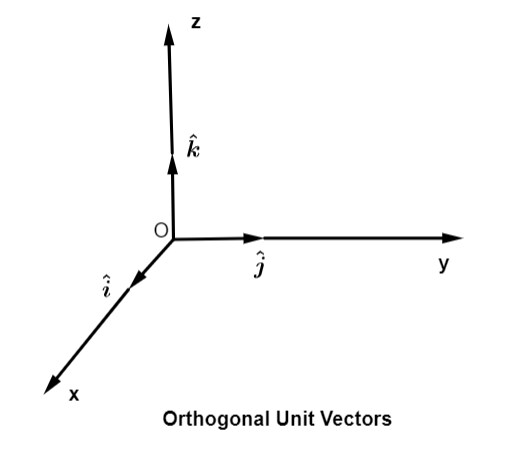
Addition of vectors:
The approach of standard algebra cannot be used to add vectors since they have both magnitude and direction. As a result, vectors can be added geometrically or analytically using vector algebra methods. The triangular law of addition or parallelogram law of vectors approach is used to discover the sum or resultant of two vectors that are inclined to each other.
By triangular law of addition method,
Magnitude of resultant vector,
The direction of the resultant vector is given by:
Subtraction of vectors:
Because vectors have both magnitude and direction, the approach of regular algebra cannot be used to subtract two vectors. As a result, this subtraction can be done analytically or geometrically.
The magnitude of the resultant vector,
The direction of the resultant vector is given by:
Multiplication of vector by a scalar:
A vector A multiplied by a scalar results in another vector A. If is a positive number, then A is also in the direction of A. It is a negative number, then A is in the opposite direction to the vector A
Scalar product of two vectors:
The scalar product, often known as the dot product of two vectors, is made up of vectors and the angle's cosine.
Thus, if there are two vectors A and B having an angle of between them, then their scalar product is defined as $A \cdot B=A B \cos \theta$.. Here, A and B are magnitudes of A and B.
Vector product of two vectors:
Definition:
The vector product is a vector with a magnitude equal to the product of the magnitudes of two vectors plus the sine of the angle between them, also known as the cross product of two vectors. The product vector is perpendicular to the plane containing the two vectors, according to the right-hand screw rule or right-hand thumb rule.
Position vector:
A position vector is a scalar that represents the position of a particle in relation to some reference frame or coordinate system at any given time.
Recommended Topic Video
Solved Example Based on Scalar and Vector
Example: Which among the following is a scalar quantity?
1) Angular velocity
2) Displacement
3) (correct) Current
4) Area of a planar surface
Solution:
Scalars: Physical quantities can be described completely by their magnitude only but no particular direction. Physical quantities which are scalars Distance, speed, work, etc.
Angular velocity, displacement, and area of the planar surface is a vector quantity because it has a specific direction. Current is a scalar quantity.
Hence, the answer is the option (3).
Example 2: Which of the following is false about scalar quantity?
1) A scalar quantity has magnitude only
2) A scalar can be either positive or negative
3) A scalar quantity can never be negative
4) None of the above
Solution:
As we learned,
-
Scalars are positive, negative or zero (E.g., temperature, T = -2 Degree C).
-
Represented by alphabet only A, B, C.
-
These physical quantities follow normal algebraic rules of addition.
Hence, the answer is the option (3).
Example 3: Which of the following sets has all the vector quantity only?
1) Current, power, Force and velocity
2) Force, torque, moment of inertia, velocity
3) Acceleration, velocity, torque, momentum
4) Speed, displacement, velocity, Force
Solution:
Vectors -Physical quantities can be described by their magnitude and directions.
E.g. Displacement, force, velocity, etc. are vectors. And current, power, moment of inertia, and speed are scalar quantities.
Hence, the answer is the option (3).
Q 4. Which of the following is not a type of vector?
1) Equal vector
2) Collinear vector
3) Co-initial vector
4) Special Vector
Solution:
Types of vectors
There are four types of vectors.
1- Equal vectors
2- Negative vectors
3- Collinear vectors
4- Co-initial vectors
Hence, the answer is the option (4).
Q 5. Two vectors are said to be equal if
1) The magnitude of the two vectors is the same.
2) The direction of two vectors is the same
3) Both magnitude and direction are the same
4) none of the above
Solution:
Equal vectors: Two vectors are said to be equal if they have equal magnitude and the same directions.
Hence, the answer is the option (3).
Summary
In physics, scalar and vector are the physical quantities in the natural world. Scalars are physical quantities that simply have a size or a numerical value (magnitude). You can determine the quantity of something using a scalar.
Also check-
- NCERT Exemplar Class 11th Physics Solutions
- NCERT Exemplar Class 12th Physics Solutions
- NCERT Exemplar Solutions for All Subjects
Related Topics Link,
- Difference Between Distance and Displacement
- Unit of Distance
- Difference Between Speed and Velocity
- Distance and Displacement
- Measurement of Speed
NCERT Physics Notes:
Also Read:
Frequently Asked Questions (FAQs)
Scalar quantity:
A scalar property is one that can only be described in terms of magnitude.
Scalar can be used to describe a variety of quantities in physics.
Distance, mass, temperature, speed, and energy are only a few examples.
Vector quantity:
Vector is a quantity that can be described in both the terms of magnitude and direction.
A vector is a directed line segment in geometry. Certain quantities in physics can only be described using vectors.
Force, velocity, displacement, position vector, acceleration, linear momentum, and rotational momentum are all examples.
Different types of vector:
Equal vectors
a) Collinear vectors
i) Parallel vectors
ii) Anti-parallel vectors
Unit vector
Orthogonal unit vectors
A unit vector is a vector whose magnitude is divided by its length. The unit vector for A is denoted by A. It has a magnitude of one or unity. As a result, we can declare that the unit vector just provides the vector quantity's direction.
The scalar product, often known as the dot product of two vectors, is made up of vectors and the angle's cosine.
The vector product is a vector with a magnitude equal to the product of the magnitudes of two vectors plus the sine of the angle between them, also known as the cross product of two vectors.